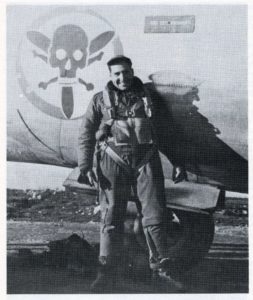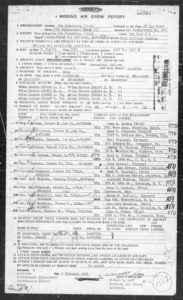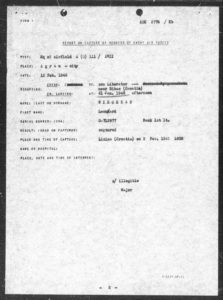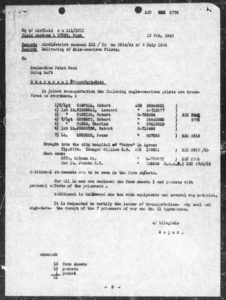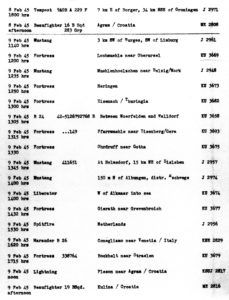I’m presently working on posts covering a variety of topics and events. I expect to continue – and perhaps expand upon? – my series of posts about Jewish servicemen reported upon in the New York Times during WW II (so very ironic, given the ideology and history of the Times regarding the Jewish people!), present detailed biographies of individual soldiers, and create posts on varied aspects of Jewish military service in the First World War. (Among other subjects!)
But, until then…
Here’s a brief update to Double Jeopardy Remembered – The Reminiscences of a Jewish Prisoner of War, which – posted in January of 2018 – presents an account by late Rabbi Leonard Winograd (formerly First Lieutenant Leonard Winograd) about his experiences as a prisoner of war in Germany during 1945. All the images and documents below, except for the very final document, also appear in that earlier post.
________________________________________
In his story, which originally appeared in The American Jewish Archives in April of 1976 (and in The Jewish Veteran later that year), Rabbi Winograd mentioned encountering a member of the South African Air Force named “Paul Kreuger”, who’d also been captured in the Mediterranean Theater in early 1945.
____________________
Lieutenant Winograd in front of a 512th Bomb Squadron B-24, upon which has been painted the squadron insignia: a skull superimposed on a propeller and cross-bones. This picture appears in Rabbi Winograd’s article in the April, 1976 issue of the American Jewish Archives, but not in either Rabbi Winograd’s Rabies is Jewish Priests, or, the reprint of the AJA article in the July, 1976 issue of The Jewish Veteran.
____________________
As Rabbi Winograd wrote, “Our select group soon included a South African pilot with the fantastic name of Paul Kreuger and there was also a South African observer whom we had seen get shot down one day as Ukrainian SS stood over me with whips in their hands while I cowered on the floor in hopes that they wouldn’t use them. (No congregation really frightens me.) We were escorted by three old men who were given rations for our trip to “someplace.” They kept our cigarette rations for themselves, but did give us enough food and a lot of organic fertilizer. We knew that they were stealing our cigarettes, but we were like Lolita with Humbert. They were all we had. They were kind of old, and we were extremely young, so we carried the guns and they carried the rations. After all, if we escaped, could they eat guns! They wanted to be sure that they would have enough to eat.”
So, a question: Who was “Kreuger”?
Answer: He was “Lieutenant Peter Krueger”, his name appearing in Luftgaukommando Report KSU (ME) 2776. Filed on February 13, 1945, KSU 2776 pertains to the transportation of Lt. Winograd and seven other Allied POWs (all aviators) to Frankfurt am Main, and, the identification of two Allied aviator casualties who had been shot down and killed. The translated report – typical of Luftgaukommando Reports – was incorporated into Missing Air Crew Report 12066 during the compilation of the latter document, subsequent to the war’s end.
____________________
Here are images of two pages from Missing Air Crew Report (MACR) 12066, which covers the loss of Lieutenant Winograd’s plane, B-24H 41-28911.
This “first” page of the MACR includes information about the mission on the the aircraft was lost, technical information about the plane itself, and information about the plane’s crew. Unlike MACRs filed for losses incurred by other numbered Air Forces of the WW II United States Army Air Force, MACRs covering 15th Air Force losses – whether for bombers, fighters, or reconnaissance aircraft – typically include information about an airman’s next-of-kin on this “first” page of the Report, rather than as a separate, “stand-alone” sheet.
Here’s the English-language translation of a “Report on Capture of Members of Enemy Air Forces” form, which is typical of Luftgaukommando Reports, in this case for the capture and identification of Lieutenant Winograd.
The central focus of this post: A document of 13 February 1945, pertaining to the transportation of eight Allied POWs to Frankfurt am Main. The eight are Lt. Winograd, five members of his crew, and, South African aviators Lieutenant Peter Krueger (207053) and the latter’s crewman F/O William G.B. Younger. The document also lists the names of shot-down Allied aviators “Gibson” and “2 Lt. Jacobs R.V.”.
KSU 2776 lists the names of six members of Lt. Winograd’s crew (T/Sgt. Robert G. Campbell, Lt. Winograd, 1 Lt. Robert J. Cartier, T/Sgt. Robert F. Corbett, T/Sgt. Charles E. Parks, and 1 Lt. Robert E. Johnston), Lt. Krueger and F/O William G.B. Younger, and finally “shot down” “Gibson”, and “2 Lt. Jacobs R.V.”.
Though listed within KSU 2776, Krueger and Younger (153881) are actually listed as being logged under Luftgaukommando Report KSE 2816, with Gibson (0-733872 – an American serial number) under KSU 2779, and Jacobs (328836) under KSU 2790.
But, when were Krueger and Younger captured? What aircraft were they flying? What squadron were they attached to?
Questions, now answered…
As seen in this list of Luftgaukommando Reports for Allied aircraft losses on February 9, 1945 KSE 2816 (ME 2816) – the lowermost entry on this sheet – pertains to a Beaufighter of No. 19 Squadron SAAF. This sheet, from Records Group 242 of the United States National Archives, is part of a list of Luftgaukommando Reports, arranged by reported date of Allied aircraft loss as recorded in German records.
NARA also holds a list of Luftgaukommando Reports alphabetically arranged by aviators’ surnames. This latter list is openly available – thus, not requiring a “pull” or declassification for access – in Room 2400 (second floor) of the National Archives at College Park, in NARA’s Textual Records Reference Division.
Consulting the list of SAAF Beaufighter losses in Winston Brent’s 85 Years of South African Air Force fits this information almost perfectly: Beaufighter X, NV121, piloted by “Lt. Kruger”, with “F/O Younger” as observer, was reported missing on the ninth of February. The plane was “Hit by flak Dobova”, according to Wikipedia “a settlement in the Municipality of Brežice in eastern Slovenia, close to the border with Croatia,” roughly fifty miles northwest of Zagreb. (Oddly, 85 Years also notes that NV121 “ditched 4 miles northeast of Termoli””, which – Termoli being on the eastern coast of Central Italy.)
Despite NV121’s reported loss at Dobova, going by KSE 2816, Krueger and Younger appear (?) to have been captured at or near “Kulina” (probably “Kutina”) Croatia, with is roughly 60-70 miles southeast of Zagreb.
Thus, given the passage of time between their plane’s loss on February 9 and the appearance of their names in KSE 2816 four days later, they are two possibilities:
The greater: The crew managed to fly southeast from Dobova, reaching the vicinity of Kutina before landing or parachuting from their plane, upon which they remained in that locale until capture.
The lesser: Having crashed at Dobova, they evaded capture over a period of four days, somehow (how?) traveling to Dobova, where they were eventually captured by Axis forces. In any event, Younger seems to have been injured or wounded, as KSU 2776 mentions that he was “brought into the city hospital at “Rebro in Agram”, “Agram” being the historic German name for Zagreb.
Notably, neither man’s name appears in the 1945 publication Prisoners of War – Naval and Air Forces of Great Britain and The Empire, 1939-1945, probably because – as specified in that compilation’s subtitle – the lists therein were only “Corrected Generally Up To 30th March 1945”.
As for “Gibson”? He turns out to have been 1 Lt. George W. Gibson of the 309th Fighter Squadron, 31st Fighter Group, who was shot down and killed while flying P-51C 43-25126 (WZ * Q) on February 2, during a strafing mission to Kurilovac Airdrome, southeast of Zagreb. (The 31st lost a total of six aircraft that day, all other pilots – all from the 308th Fighter Squadron – surviving.) His loss is covered in MACR 11820. He is buried at the Maplewood Memorial Cemetery, in Emporia, Kansas.
And “R.V. Jacobs”? He was Lieutenant Raymond Vernon Jacobs (328838V) of No 249 Squadron, RAF. The pilot of Mustang III FB308 (GN * E), he was shot down and killed on February 2, 1945, albeit KSU 2790 incorrectly lists the date as February 3. He is buried at the Belgrade War Cemetery, in Serbia.
________________________________________
Postwar: Rabbi Leonard Winograd, formerly Lieutenant Leonard Winograd. (Portrait from Rabies is Jewish Priests)
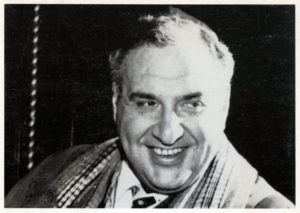 ________________________________________
________________________________________
So, a small question from forty-four years ago is now answered.
References
Brent, Winston, 85 Years of South African Air Force – 1920-2005, Freeworld Publications cc, Nelspruit, South Africa, 2005
Prisoners of War – Naval and Air Forces of Great Britain and The Empire, 1939-1945 (All Lists Corrected Generally Up To 30th March 1945), His Majesty’s Stationary Office, 1945 (republished by J.B Hayward & Son, Polstead, Suffolk, England, 1990)
Lieutenant Raymond Vernon Jacobs of No. 249 Squadron RAF, at RAF Commands (1)
Lieutenant Raymond Vernon Jacobs of No. 249 Squadron RAF, at RAF Commands (2)

